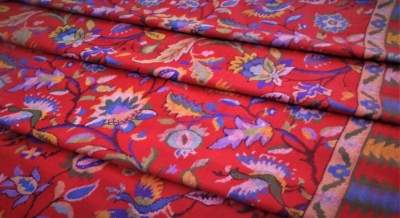New Delhi (IANSlife) At the age of 42, Varuna Anand decided to be an entrepreneur and founded The Splendor of Kashmir (SOK) which endeavours to take the famed art of shawl making from Jammu and Kashmir to the admirers, both within India and overseas.
A textile designer by profession, Anand has spent many years learning and designing home textiles and sarees for the likes of House of Fraser, John Lewis, Galleries Lafayette Printemps, Laura Ashley, Tommy Hilfiger and Satya Paul.
In a conversation with IANSlife, Anand shares more about the idea behind her brand, her journey in the industry and the handicraft market in the Valley post scrapping of Article 370.
Read excerpts:
Q) What was your idea behind SOK?
The Splendor of Kashmir started with an idea of being a bridge between the well deserving craftsmen and the admirers of this ancient art. I think we can term it as a combination of various factors like destiny, being in the right place at the right time. Having lived in Delhi, I was well aware of what kind of shawls reach the end consumer and then after coming to Jammu and Kashmir by virtue of my marriage in 2002. I started observing the difference of the shawls draped by the ladies in the state and what we would see living out of the state. The difference was large and most contrasting and this was one of the prime reasons to carry the best of the state to admirers and collectors of this renowned handicraft.
Q) How has your journey been till now?
My journey has been one of life’s greatest learning periods so far. I never thought I would get so involved with my work and be so passionate about it, but in these eight years I learned many life lessons as I slowly progressed with my work. I learnt that there is no substitute to hard work, it is the key mantra to succeed. Honesty and dedication can make your progress gradual but positively substantial. Selling is not just about numbers, it’s a process of imparting what you have learned and making a place in someone’s life. Only when a client inspires confidence in you does he/she desires to buy from your collection and further refer your name to family and friends. This chain is the building block to your progress. At the age of 42, I decided to be an entrepreneur, it’s certainly not easy, it was the blessings of the almighty and the help and support of so many people who touched my life and gave me the strength to move forward.
Q) What challenges did you face?
The art of shawl making from Kashmir is a very integral part of one of the largest cottage industries of the Kashmir. True to any state of India which excels in some or the other form of handicraft, in Kashmir a large number of lives are involved in this craft and probably know this as the only way to earn their bread and butter. It is a craft which comes down generations and now off course the government has many centers to teach the art of shawl weaving to many aspirants. I am based in Jammu and could be connected to the right craftsmen, thanks to my husband whose family has been living here for seven generations. Not speaking the local language is also a huge barrier but I can get my point across to the people who manage the production and further convey it to the craftsmen. Political instability and the strife in Kashmir also add many challenges in our production from time to time.
Q) How difficult or easy it is to work with Pashmina?
Pashmina is a very fragile fabric and requires great expertise to work on it. It is only these craftsmen from Kashmir who have the ability to embroider so extensively on a fragile fabric like Pashmina with such finesse. The expertise of the craftsman’s work is seen with the high quality of embroidery done on the shawl making it hard to differentiate between the front and back of the embroidery. It is not just the expertise of the craftsmen but also the people who dye the yarn, finish the final product removing all stains. The rufugar who hides all the flaws by his immaculate darning of the shawl. All this being possible only in Kashmir as there is a chain of people involved from the inception of the product to the finishing of the final piece.
Q) Pashmina has been quite popular even outside India. What kind of response have you got?
Pashmina and its products have always been a luxury product. Being expensive in nature it is not a mass product so has always enjoyed a niche clientele. This art has many admirers both in India and overseas who understand the work involved in creating every piece hence hold it as a revered textile. Since India has a rich heritage of textiles and crafts, sometimes we tend to undermine our heritage but not to say that people don’t appreciate this art or not collectors of it. I have so many clients who are ardent admirer of this craft and very proud of our heritage.
There have been many instances when I am amazed with my interaction with a foreign client and their love for this textile. But what is most surprising is the extent of knowledge a foreigner can have on this textile and their admiration for it.
Q) How do you think scrapping of Article 370 will affect the handloom market back in the Valley?
Peace has to prevail in the valley for the smooth running of life or any industry and that is what we all pray and hope for. This handicraft is the bread and butter of a large population of Kashmir and we hope life goes on smoothly for everyone.
Cutting off of communication and the disruption of life has affected all business connected with Kashmir, our prayers for the return of normalcy, peace, growth and prosperity for everyone.
Q) What are you expansion plans?
Our reach is gradually increasing, our module of selling is though exhibitions and online for overseas sales. We would like to add many more cities across India to increase our reach to more and more people and then start carrying exhibitions overseas too.

